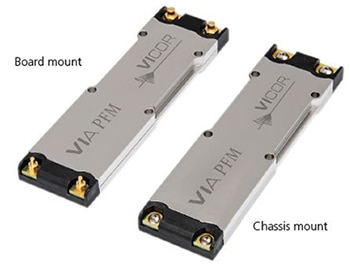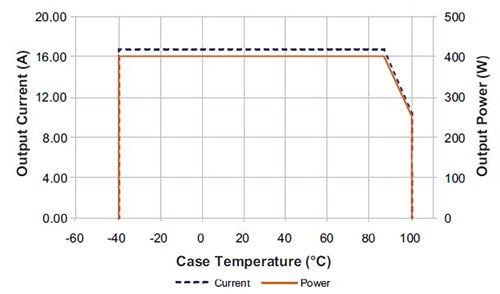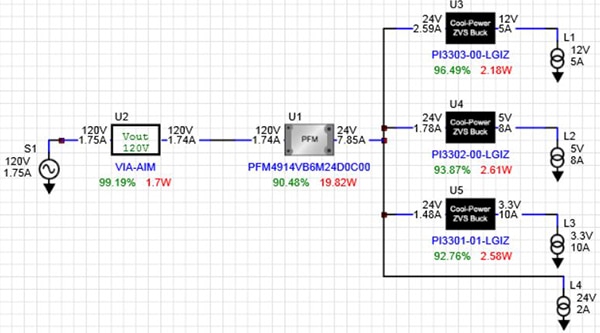Low-Profile, High-Density AC/DC Modules Reshape Front-End Power Supplies
投稿人:电子产品
2015-10-13
While the density of AC/DC converters has improved over the years, its physical profile seems to have taken a back seat. However, with power supply customers now demanding improvements on all fronts, to succeed in the marketplace modern AC/DC power systems must be small, reliable, easy-to-use, and cost competitive while, at the same time, demonstrating leading-edge efficiency, high-power factor, and low conducted and radiated emissions. Vicor has tackled these tough tasks by combining advanced power conversion engines and electromagnetic compatibility functions inside the thermally adept and ultra-low-profile Vicor Integrated Adapter (VIA) package.
As a result, Vicor has introduced VIA PFM (in, for example, its PFM4914BB6M24D0C08) modules that boast unprecedented power density of 127 W/in3 with a profile that is 5x thinner than a traditional 1U power supply. All while supplying an isolated, regulated 24 V or 48 V safety extra-low-voltage (SELV) DC output at up to 400 W from a universal AC input of 85 to 264 VAC with 93 percent peak efficiency. What is more, the AC/DC power modules are power-factor corrected (PFC), achieving a power factor (PF) of 0.95 over most operating conditions. The PF value may not be high in comparison with the other AC/DC supplies with PFC, but it’s very good considering its size, claims the manufacturer.
Advance packaging technology
According to Vicor, the 9 mm-thin VIA power modules integrate system functions including AC/DC conversion, EMI filtering, transient protection, and inrush current limiting to reduce design time and design risk while offering high-efficiency performance and unprecedented power density. It offers a compact footprint of just 35.5 mm wide with lengths ranging from 72 mm to 141 mm. The modules are tailored to enable power-system designers to create highly dense, efficient, flexible, and scalable power systems. Available in chassis- and PCB-mount configurations (Figure 1), the thermally efficient VIA power modules with ultra-low profiles support a multiplicity of mechanical-mounting and thermal-management options.

Figure 1: The low-profile, thermally efficient VIA power modules are available in chassis- and PCB-mount configurations. (Courtesy of Vicor)
In fact, the VIA package is designed to provide effective conduction cooling from either side of the module surface. As a result, heat can be removed from the top surface, the bottom surface, or both. Thus, to simplify thermal design, it requires heatsinking on only one side. In the case of the chassis-mount version, the system chassis is part of the thermal design, minimizing requirements for fans in many applications, thereby further reducing the space required for the AC/DC front-end solution.
According to the product data sheet, the extent to which the two surfaces are cooled is a key component for determining the maximum power that can be processed by a VIA module, as evident from the specified thermal operating area depicted in Figure 2. Also, because the VIA has a maximum internal temperature rating, it is necessary to estimate this internal temperature based on a system-level thermal solution, according to Vicor. For that, Vicor engineers have created a thermal model which is described in the product data sheet.

Figure 2: The thermally efficient VIA package offers a wide operating area. (Courtesy of Vicor)
While VIA PFM modules integrate a lot of functions in a single package, it is not a complete AC/DC front-end solution. In order to build a complete AC to 48 VDC or 24 VDC supply, it requires a rectifier, fuse, and metal-oxide varistor (MOV) at the input and hold-up capacitors at the output as shown in Figure 3. As the unit supports universal input, a single design can work across the globe, meeting all agency standards for PF, harmonics, EMI, surge and other, similar, parameters. Consequently, it is aimed at applications where power density is a major requirement along with high performance, flexibility, and ease of use.

Figure 3: For a complete AC/DC front-end solution, the VIA PFM module requires a rectifier, fuse, and metal-oxide varistor (MOV) at the input and hold-up capacitors both at the input and the output. (Courtesy of Vicor)
With a 9 mm profile and a width of just 36 mm, the VIA PFM can be mounted on the sidewall of a typical 1U chassis, saving a significant amount of valuable real estate in the system. Since it offers a low thermal resistance, it can be conduction cooled, eliminating the need for fans, in this way further reducing the system space required while enhancing system reliability. Target applications include small cell base stations, telecom equipment, DIN rail power systems, LED lighting, test and measurement systems, and numerous other industrial systems.
AC to point-of-load solution
In essence, VIA PFM is a building block for an AC to the point-of-load (POL) solution. The manufacturer offers a number of DC/DC converters and regulators that can be combined with VIA PFM front-end AC/DC modules to create the desired AC to POL power chain. Currently, there are two regulated, isolated outputs from the VIA PFM family. While PFM4914VB6M24D0C00 offers regulated, isolated 24 VDC output, PFM4914BB6M48D0C04 is a 48 VDC output version. Depending on the output, the module can be combined with Vicor’s POL regulators like the Cool-Power ZVS buck regulators to generate the desired output voltages to drive the semiconductor loads and other functions like LEDs and amplifiers.
A typical example of generating four DC output voltages to drive various loads using AC/DC front-end VIA PFM module and corresponding Cool-Power ZVS regulators is presented in Figure 4. DC-output voltages generated include 12 V using buck regulator PI3303-00-LGIZ, 5 V using buck regulator PI3302-00-LGIZ, 3.3 V using buck regulator PI3301-01-LGIZ, and 24 V directly from the PFM output.

Figure 4: Generating four POL DC-output voltages using 24 V output PFM4914VB6M24D0C00 module and three Cool Power ZVS buck regulators. (Courtesy of Vicor)
In short, by combining Vicor’s high-density, high-performance low-profile integrated AC/DC front-ends with the company’s high-efficiency, high-density DC/DC converters and buck regulators, system designers can quickly and easily generate an AC to the point-of-load solution as required by the system.
For more information on the products discussed in this article, use the links provided to access product pages on the DigiKey website.
免责声明:各个作者和/或论坛参与者在本网站发表的观点、看法和意见不代表 DigiKey 的观点、看法和意见,也不代表 DigiKey 官方政策。








 中国
中国